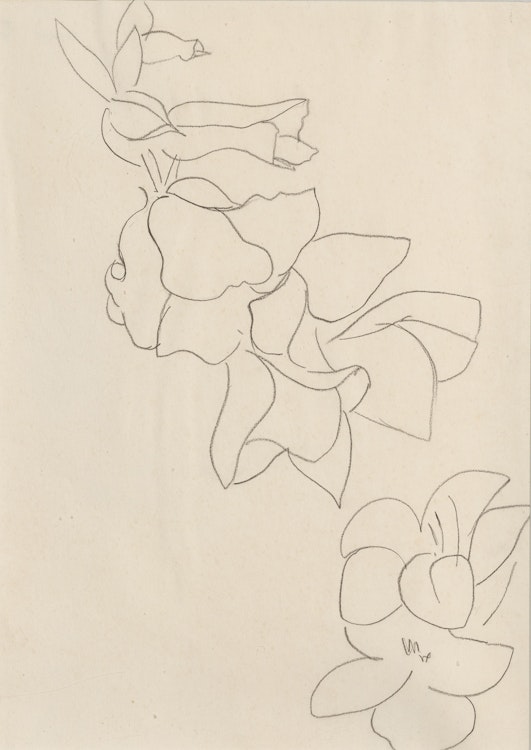Fleurs et feuilles, 1942 by Henri Matisse

Henri Matisse
Fleurs et feuilles, 1942
conte on paper
14.5 x 10.5 in ( 36.8 x 26.7 cm ) ( sheet )
Auction Estimate: $20,000.00 - $40,000.00
Price Realized $31,200.00
Sale date: May 28th 2025
Pierre Matisse, New York
By descent to Pierre-Noël Matisse, Paris
The Estate of Jacquelyne Miller Matisse
Christie's, auction, New York, 8-15 February 2023, lot 27
Private Collection
John Elderfield, "The Drawings of Henri Matisse", New York, 1985, page 84
Throughout his career, flowers and plants were recurrent themes in Matisse’s work. As demonstrated in this drawing, they often served as decoration within his larger compositions or as standalone subjects. This work presents delicate flowers in bloom, with rounded and tightly clustered petals juxtaposed against thin, elongated leaves in the upper left corner. The organic, repetitive shapes of flowers and plants provided Matisse with an ideal medium for expressing his flowing, linear designs. Ultimately, he believed that drawing allowed him “to consider simultaneously the character of the model, the human expression, the quality of surrounding light, atmosphere and all that can only be expressed by drawing.”
Georges Matisse has confirmed the authenticity of this work.
Share this item with your friends
Henri Matisse
(1869 - 1954)
Henri Matisse is considered one of the most influential French artists of the twentieth century, renowned for his radical stylistic choices, later known as Fauvism. He was born in Le Cateau-Cambrésis, France. After studying law in Paris, he attended the Académie Julian and the École des Beaux-Arts. His early works reflected a more naturalistic style, but after studying the Impressionists and the Pointillism of artists like Georges Seurat, his style became increasingly experimental. Matisse explored a variety of mediums, including painting, drawing, sculpture, graphic art, and paper cut-outs. By the mid-1900s, he had developed his mature Fauvist style, characterized by dynamic pieces that employed large swaths of bright colour in flat applications of paint with bold outlines. His career as an artist can be divided into three distinct stages: the 1910s were marked by abstract paintings; the 1920s, known as his “Nice period”, featured decorative and sunlit interiors; and in the last decade of his career, he focused on innovative paper cut-outs, including works like "Blue Nude II" from 1952.
Matisse's works received critical acclaim during his lifetime and continue to have a lasting impact. In 1951, he held a retrospective of his works at the Museum of Modern Art in New York. Three years later, a museum dedicated to his art, the Musée Matisse, opened in his hometown. Today, his works can be found in institutions such as the Musée d’Orsay in Paris, the MoMA in New York, the National Gallery in London, and the Hermitage Museum in St. Petersburg, among others.

